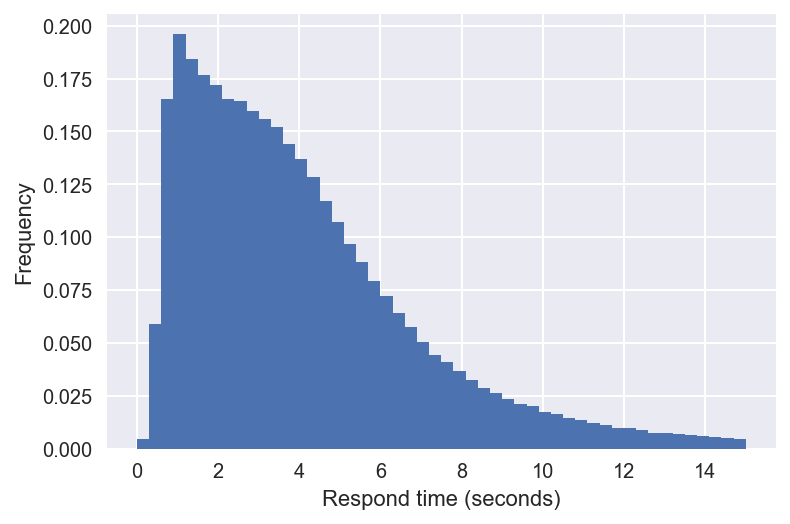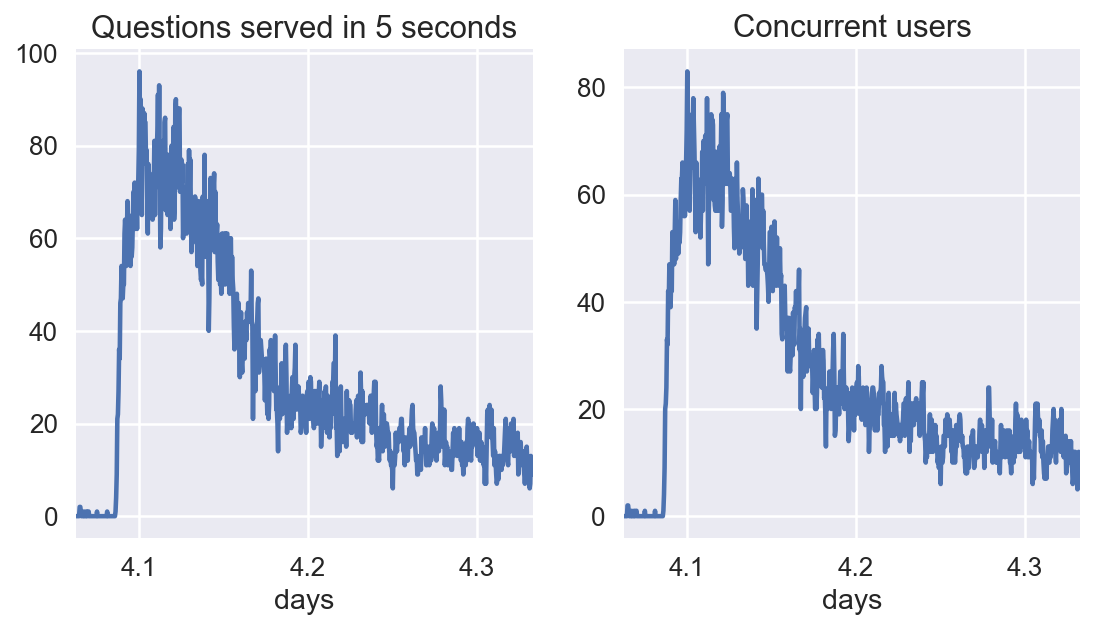How does the system perform?¶
This notebook will look the following:
How long do users wait to answer questions?
How long do users wait for the network to respond?
How many simultaneous users do we have?
How many simultaneous requests are served?
[1]:
%matplotlib inline
import pandas as pd
import matplotlib.pyplot as plt
import numpy as np
plt.style.use('seaborn')
[2]:
import caption_contest_data as ccd
responses = ccd.responses(577)
print("Number of responses:", len(responses))
responses.columns
Number of responses: 389898
[2]:
Index(['alg_label', 'network_delay', 'participant_uid', 'response_time',
'target', 'target_id', 'target_reward', 'timestamp_query_generated',
'label', 'contest', 'filename'],
dtype='object')
[3]:
responses.iloc[0]
[3]:
alg_label KLUCB
network_delay 0.670163
participant_uid eea58658d9d40ceaf97f0bccbfa324_BuIKwH3xGWWASxp...
response_time 28.324
target Your mother and I don't think working from hom...
target_id 4181
target_reward 2
timestamp_query_generated 2017-07-28 17:05:39.090118
label somewhat_funny
contest 577
filename 577-responses.csv
Name: 0, dtype: object
Response time¶
How long does the average user wait before providing a respose? That data is recorded in the responses and we can plot a histogram.
We know that waiting for something to happen is characterized by an exponential random variable. Can we fit the PDF of an exponential random variable to the reponse time we see?
[4]:
most_responses = (responses['response_time'] >= 0) & (responses['response_time'] <= 15)
df = responses[most_responses].copy()
[5]:
df['response_time'].plot.hist(bins=50, normed=True)
plt.xlabel('Respond time (seconds)')
plt.show()
/Users/scott/anaconda3/envs/ccd-api3/lib/python3.7/site-packages/pandas/plotting/_matplotlib/hist.py:62: MatplotlibDeprecationWarning:
The 'normed' kwarg was deprecated in Matplotlib 2.1 and will be removed in 3.1. Use 'density' instead.
n, bins, patches = ax.hist(y, bins=bins, bottom=bottom, **kwds)
[6]:
users = df.participant_uid.unique()
num_users = len(users)
print(num_users, "total users")
9628 total users
Network delay¶
How long does our system take to respond?
[7]:
most_delays = (responses['network_delay'] >= 0) & (responses['network_delay'] <= 2)
df = responses[most_delays]
[8]:
plt.style.use('seaborn-talk')
df['network_delay'].plot.hist(bins=100)
plt.title('Network delay')
plt.show()
Concurrent users¶
How many users hit our system in a one second period?
[9]:
import datetime
df = responses.copy()
contest_start = df['timestamp_query_generated'].min()
contest_end = df['timestamp_query_generated'].max()
df = df.sort_values(by='timestamp_query_generated')
delta = datetime.timedelta(seconds=1)
df['seconds_elapsed'] = df['timestamp_query_generated'] - contest_start
df['seconds_elapsed'] = df.apply(lambda row: row['seconds_elapsed'].total_seconds(), axis=1)
[10]:
total_seconds = (contest_end - contest_start).total_seconds()
[14]:
def find_users_in_range(start, k, total, resolution=None, times=None, participants=None):
if k % 1000 == 0:
print(k / total, "fraction")
end = start + resolution
n_questions = (times >= start) & (times < end)
n_users = participants[n_questions].nunique()
return {'questions served': n_questions.sum(), 'n_users': n_users, 'start': start, 'end': end}
[15]:
from joblib import Parallel, delayed
times = df['seconds_elapsed'].values.astype("float32")
participants = df["participant_uid"].apply(hash)
measure = np.linspace(times.min(), times.max(), num=20_000)
print(np.diff(measure).min())
resolution = 5 # seconds
print(f"Launching {len(measure)//1000}k jobs...")
print(f"Resolution: {resolution} seconds")
30.568269038340077
Launching 20k jobs...
Resolution: 5 seconds
[17]:
kwargs = {"resolution": resolution, "times": times, "participants": participants}
stats = []
for k, m in enumerate(measure):
stat = find_users_in_range(m, k, len(measure), **kwargs)
stats.append(stat)
0.0 fraction
0.05 fraction
0.1 fraction
0.15 fraction
0.2 fraction
0.25 fraction
0.3 fraction
0.35 fraction
0.4 fraction
0.45 fraction
0.5 fraction
0.55 fraction
0.6 fraction
0.65 fraction
0.7 fraction
0.75 fraction
0.8 fraction
0.85 fraction
0.9 fraction
0.95 fraction
[18]:
print(stats[:3])
[{'questions served': 1, 'n_users': 1, 'start': 0.0, 'end': 5.0}, {'questions served': 0, 'n_users': 0, 'start': 30.568269038451923, 'end': 35.56826903845192}, {'questions served': 0, 'n_users': 0, 'start': 61.13653807690385, 'end': 66.13653807690385}]
[19]:
stats = pd.DataFrame(stats)
stats["minutes"] = stats["start"] / 60
stats["hours"] = stats["minutes"] / 60
stats["days"] = stats["hours"] / 24
[20]:
stats.sample(n=5)
[20]:
| questions served | n_users | start | end | minutes | hours | days | |
|---|---|---|---|---|---|---|---|
| 12154 | 19 | 17 | 371526.741893 | 371531.741893 | 6192.112365 | 103.201873 | 4.300078 |
| 13255 | 1 | 1 | 405182.406105 | 405187.406105 | 6753.040102 | 112.550668 | 4.689611 |
| 16981 | 0 | 0 | 519079.776542 | 519084.776542 | 8651.329609 | 144.188827 | 6.007868 |
| 17872 | 1 | 1 | 546316.104255 | 546321.104255 | 9105.268404 | 151.754473 | 6.323103 |
| 2474 | 3 | 2 | 75625.897601 | 75630.897601 | 1260.431627 | 21.007194 | 0.875300 |
[21]:
max_rate = stats['questions served'].max()
print(f'Questions served per {resolution} seconds: {max_rate}')
Questions served per 5 seconds: 96
[22]:
import matplotlib.pyplot as plt
w = 4.5
fig, axs = plt.subplots(ncols=2, figsize=(2 * w, 1*w))
ax = stats.plot(x="days", y="questions served", ax=axs[0])
ax.set_title(f"Questions served in {resolution} seconds")
ax.legend_.remove()
ax = stats.plot(x="days", y="n_users", ax=axs[1])
ax.set_title("Concurrent users")
ax.legend_.remove()
[23]:
idx = (97.5<= stats.hours) & (stats.hours <= 104)
w = 4.5
fig, axs = plt.subplots(ncols=2, figsize=(2 * w, 1*w))
ax = stats[idx].plot(x="days", y="questions served", ax=axs[0])
ax.set_title(f"Questions served in {resolution} seconds")
ax.legend_.remove()
ax = stats[idx].plot(x="days", y="n_users", ax=axs[1])
ax.set_title("Concurrent users")
ax.legend_.remove()
[ ]:



